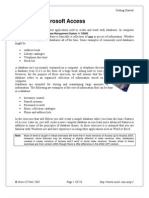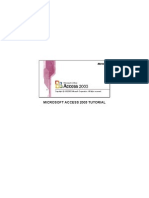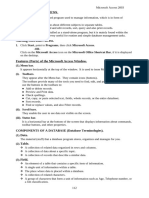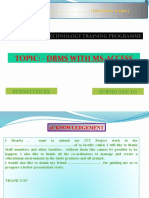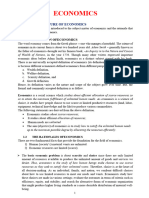0 ratings0% found this document useful (0 votes)
179 viewsIntroduction To Database Software
This document provides an introduction and overview of database software and Microsoft Access 2003. It outlines the key objectives and features students should understand after completing the lesson. These include being able to state the usage of database software, start and identify features of Access 2003, and understand the main toolbars and icons. The document then provides step-by-step instructions on how to start Access 2003, create a new database file, and open an existing database file. It also describes some of the main objects in Access 2003 like tables, forms, queries and reports.
Uploaded by
Peah J JambuCopyright
© © All Rights Reserved
Available Formats
Download as PPT, PDF, TXT or read online on Scribd
0 ratings0% found this document useful (0 votes)
179 viewsIntroduction To Database Software
This document provides an introduction and overview of database software and Microsoft Access 2003. It outlines the key objectives and features students should understand after completing the lesson. These include being able to state the usage of database software, start and identify features of Access 2003, and understand the main toolbars and icons. The document then provides step-by-step instructions on how to start Access 2003, create a new database file, and open an existing database file. It also describes some of the main objects in Access 2003 like tables, forms, queries and reports.
Uploaded by
Peah J JambuCopyright
© © All Rights Reserved
Available Formats
Download as PPT, PDF, TXT or read online on Scribd
You are on page 1/ 26
Lesson 01:
Introduction to Database Software
At the end of this lesson, students
should be able to:
State the usage of database software.
Start a database software.
State the steps of starting database
software.
State and identify features in database
software and demonstrate understanding
of user interface
State the main toolbars in database
software: Database bar, Database
Window bar, Object bar
List icons in the database bar, database
window bar and object bar.
State the functions of icons in database
bar, database window bar and object bar.
At the end of this lesson, students
should be able to:
Introduction to Database Software
Example of
database
Example of
database
Introduction to Database Software
software creating of database
A database is the computer equivalent
of an organized list of information.
Typically, this information has a
common subject or purpose, such as
the list of employees, phonebook guide
or a classmates address book.
Meaning of Database
Microsoft Access 2003 (Access 2003) is
a database system management
(database programs). It can store,
manage, manipulate, analyze, retrieve,
display or publish information from
database.
Continue
Data can be stored systematically
Reduce space of storing data
Ease to retrieve, update, delete,and
store data
Reduce time to manage data
Usage of Database Software
This is icon MS Access 2003
Starting MS Access 2003
1. There are two methods to start / launch your
Microsoft Access 2003.
Method 1:
Shortcut icon MS Access 2003
Click-on the Start button, then click All
Programs, then click-on Microsoft Access
2003 (Figure 1)
Method 2:
Figure 1
2. The following Access 2003 Getting Started
Task Pane will appear on the right side of
your Access 2003 screen. (refer figure 2).
3. In the Open area of the Access
2003 Getting Started Task
Pane, click the left mouse
button on Create a new file.
Figure 2
4. The New File menu screen on the top will
appear when you click the left mouse
button on Create a new file.
5. Clickon Blank database. (Figure 3)
Click here
Figure 3
6. A File New Database menu screen,
similar to the one below, will be on your
screen. Well have to do several
things to set-up this screen to save
your database. ( Figure 4 )
Figure 4
7. Click-on the small down arrow on the right.
Choose My Documents to save by double
clicking on the folder. Your selection should
now appear in the Save in : area. (Step 1)
Step 1
Figure 5
8. Next click-in the area to the right of File
Name. Type-in the word students profile
as shown at the bottom of the above
image. (Step 2)
Step 2
Figure 6
9. Now click-on the Create button. (Step 3)
Step 3
Figure 7
Click students profile. (refer Figure 8)
Click
Students profile
Figure 8
10. The following Students Profile: Database
menu screen will appear. ( Figure 9 )
Figure 9
11. Click File and click Exit to end this session
and to close Ms Access 2003
Once you have created a database, you will
see your database in the Open portion of the
Task Pane.
Open Existing Database
1. There are two methods to open existing
database:
Method 1:
Click File in the Menu Bar, then click Open.
(refer figure 10)
Method 2:
Figure 10
3. When the Open menu screen appears, click
the small down arrow to the right of the
Look in area and select My Documents.
4. Then click the name of your database (e.g.
students profile.mdb) and then click Open.
Select
My Documents
Click
students profile
Figure 11
Tables, Queries, Forms, Report,
Pages, Macros and Modules.
Database
window title bar
Objects bar
Groups bar
Database
window
Database window
menu bar
Database
toolbar
Access window
title bar
Database window
toolbar bar
Figure 12
There are 4 important objects as stated in the
table below.
Objects
Bar
Function
Table
A collection of records that identify a
category of data, such as Customers,
Orders, or Inventory. Data inside a
table is arrange by column name field
and row named Record.
Field A single characteristic or
attribute of a person, place, object,
event, or idea.
Record A set of related field values.
Objects
Bar
Function
Form
Use to enter new information, to edit
or remove existing information or to
locate information.
Query
Used to locate information, to view,
change or analyze it in various ways.
A select query retrieves data from
one or more tables and displays the
result in datasheet. A select query
can be used to group record and
calculate sums, counts, averages
and other types of totals.
Continue
Objects
Bar
Function
Report
Typically used to summarize,
organize and analyze information in
order to express a particular point of
view to specific audience.
Continue
Exit Database
Click File and Exit to stop this session
(refer figure 13)
Figure 13
You might also like
- 9441 Panasonic SA-PM500 Sistema Audio Estereo CD-iPOD-USB Manual de ServicioNo ratings yet9441 Panasonic SA-PM500 Sistema Audio Estereo CD-iPOD-USB Manual de Servicio115 pages
- Chapter 12 Homeostasis - Tutorial Worksheet100% (4)Chapter 12 Homeostasis - Tutorial Worksheet4 pages
- Basic Elements of Access2003.: Opening and Closing AccessNo ratings yetBasic Elements of Access2003.: Opening and Closing Access14 pages
- Introduction To Microsoft (MS) Access PPT CentumNo ratings yetIntroduction To Microsoft (MS) Access PPT Centum56 pages
- Access 2007 - Exploring An Access DatabaseNo ratings yetAccess 2007 - Exploring An Access Database40 pages
- OceanofPDF.com Access in Easy Steps - Mike McGrathNo ratings yetOceanofPDF.com Access in Easy Steps - Mike McGrath325 pages
- Microsoft Access 2003: ICS 014 - 042 YazdaniNo ratings yetMicrosoft Access 2003: ICS 014 - 042 Yazdani78 pages
- Lecture 5 Staring MS Access Access ObjectsNo ratings yetLecture 5 Staring MS Access Access Objects23 pages
- Access - 2019 - DIT 1st Semester & 2nd SemesterNo ratings yetAccess - 2019 - DIT 1st Semester & 2nd Semester109 pages
- A Project Report On MS Access With DatabaseNo ratings yetA Project Report On MS Access With Database55 pages
- 1.1 Introduction: What Is Access?: 1.1.1 The Many Faces of AccessNo ratings yet1.1 Introduction: What Is Access?: 1.1.1 The Many Faces of Access17 pages
- WDDBAOperate Database Application and Access and Use Database ApplicationNo ratings yetWDDBAOperate Database Application and Access and Use Database Application31 pages
- (Ebook - PDF) Microsoft Access TutorialNo ratings yet(Ebook - PDF) Microsoft Access Tutorial95 pages
- Creating Database Tables: Software OrientationNo ratings yetCreating Database Tables: Software Orientation11 pages
- Microsoft Access: Database Creation and Management through Microsoft AccessFrom EverandMicrosoft Access: Database Creation and Management through Microsoft AccessNo ratings yet
- Microsoft Access For Beginners: The Complete Step-By-Step User Guide For Mastering Microsoft Access, Creating Your Database For Managing Data And Optimizing Your Tasks (Computer/Tech)From EverandMicrosoft Access For Beginners: The Complete Step-By-Step User Guide For Mastering Microsoft Access, Creating Your Database For Managing Data And Optimizing Your Tasks (Computer/Tech)No ratings yet
- Tableau Training Manual 9.0 Basic Version: This Via Tableau Training Manual Was Created for Both New and IntermediateFrom EverandTableau Training Manual 9.0 Basic Version: This Via Tableau Training Manual Was Created for Both New and Intermediate3/5 (1)
- Excel Essentials: A Step-by-Step Guide with Pictures for Absolute Beginners to Master the Basics and Start Using Excel with ConfidenceFrom EverandExcel Essentials: A Step-by-Step Guide with Pictures for Absolute Beginners to Master the Basics and Start Using Excel with Confidence5/5 (1)
- Cold Buster - INSTALLATION-Slab-Manual-JUL-2023No ratings yetCold Buster - INSTALLATION-Slab-Manual-JUL-202312 pages
- Servers - Preventive Maintenance Report 3 April 2023No ratings yetServers - Preventive Maintenance Report 3 April 20237 pages
- From Egypt To Mesopotamia A Study (Samuel - Mark)100% (6)From Egypt To Mesopotamia A Study (Samuel - Mark)225 pages
- Official Ncm0200 Baird Parker Agar Base Technical Specifications en UsNo ratings yetOfficial Ncm0200 Baird Parker Agar Base Technical Specifications en Us3 pages
- Sanitary Sewer Peaking Factors For Very Low Flows - A Study100% (1)Sanitary Sewer Peaking Factors For Very Low Flows - A Study4 pages
- University of Salahaddin College of Engineering Civil DepartmentNo ratings yetUniversity of Salahaddin College of Engineering Civil Department17 pages
- Negotiating Contractual Limitations of Liability Provisions PDFNo ratings yetNegotiating Contractual Limitations of Liability Provisions PDF53 pages
- 9441 Panasonic SA-PM500 Sistema Audio Estereo CD-iPOD-USB Manual de Servicio9441 Panasonic SA-PM500 Sistema Audio Estereo CD-iPOD-USB Manual de Servicio
- Basic Elements of Access2003.: Opening and Closing AccessBasic Elements of Access2003.: Opening and Closing Access
- OceanofPDF.com Access in Easy Steps - Mike McGrathOceanofPDF.com Access in Easy Steps - Mike McGrath
- 1.1 Introduction: What Is Access?: 1.1.1 The Many Faces of Access1.1 Introduction: What Is Access?: 1.1.1 The Many Faces of Access
- WDDBAOperate Database Application and Access and Use Database ApplicationWDDBAOperate Database Application and Access and Use Database Application
- Microsoft Access for Beginners and IntermediatesFrom EverandMicrosoft Access for Beginners and Intermediates
- Crystal Reports Introduction: Versions 2008-2016From EverandCrystal Reports Introduction: Versions 2008-2016
- Microsoft Access: Database Creation and Management through Microsoft AccessFrom EverandMicrosoft Access: Database Creation and Management through Microsoft Access
- THE MICROSOFT WORD GUIDE From Basics to BrillianceFrom EverandTHE MICROSOFT WORD GUIDE From Basics to Brilliance
- Microsoft Access For Beginners: The Complete Step-By-Step User Guide For Mastering Microsoft Access, Creating Your Database For Managing Data And Optimizing Your Tasks (Computer/Tech)From EverandMicrosoft Access For Beginners: The Complete Step-By-Step User Guide For Mastering Microsoft Access, Creating Your Database For Managing Data And Optimizing Your Tasks (Computer/Tech)
- Tableau Training Manual 9.0 Basic Version: This Via Tableau Training Manual Was Created for Both New and IntermediateFrom EverandTableau Training Manual 9.0 Basic Version: This Via Tableau Training Manual Was Created for Both New and Intermediate
- Microsoft Word for Beginners and IntermediatesFrom EverandMicrosoft Word for Beginners and Intermediates
- Excel Essentials: A Step-by-Step Guide with Pictures for Absolute Beginners to Master the Basics and Start Using Excel with ConfidenceFrom EverandExcel Essentials: A Step-by-Step Guide with Pictures for Absolute Beginners to Master the Basics and Start Using Excel with Confidence
- Tableau 8.2 Training Manual: From Clutter to ClarityFrom EverandTableau 8.2 Training Manual: From Clutter to Clarity
- Servers - Preventive Maintenance Report 3 April 2023Servers - Preventive Maintenance Report 3 April 2023
- Official Ncm0200 Baird Parker Agar Base Technical Specifications en UsOfficial Ncm0200 Baird Parker Agar Base Technical Specifications en Us
- Sanitary Sewer Peaking Factors For Very Low Flows - A StudySanitary Sewer Peaking Factors For Very Low Flows - A Study
- University of Salahaddin College of Engineering Civil DepartmentUniversity of Salahaddin College of Engineering Civil Department
- Negotiating Contractual Limitations of Liability Provisions PDFNegotiating Contractual Limitations of Liability Provisions PDF













